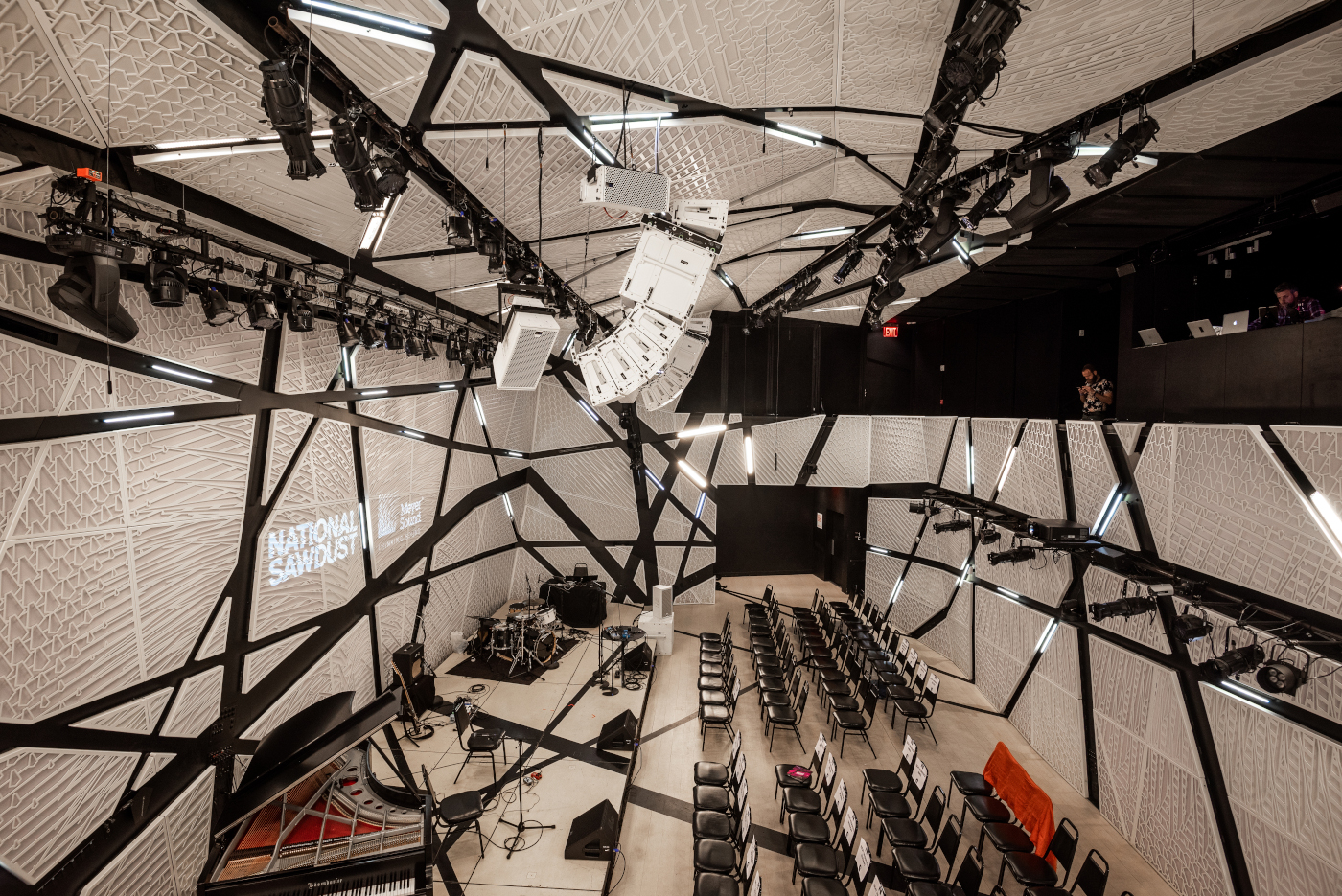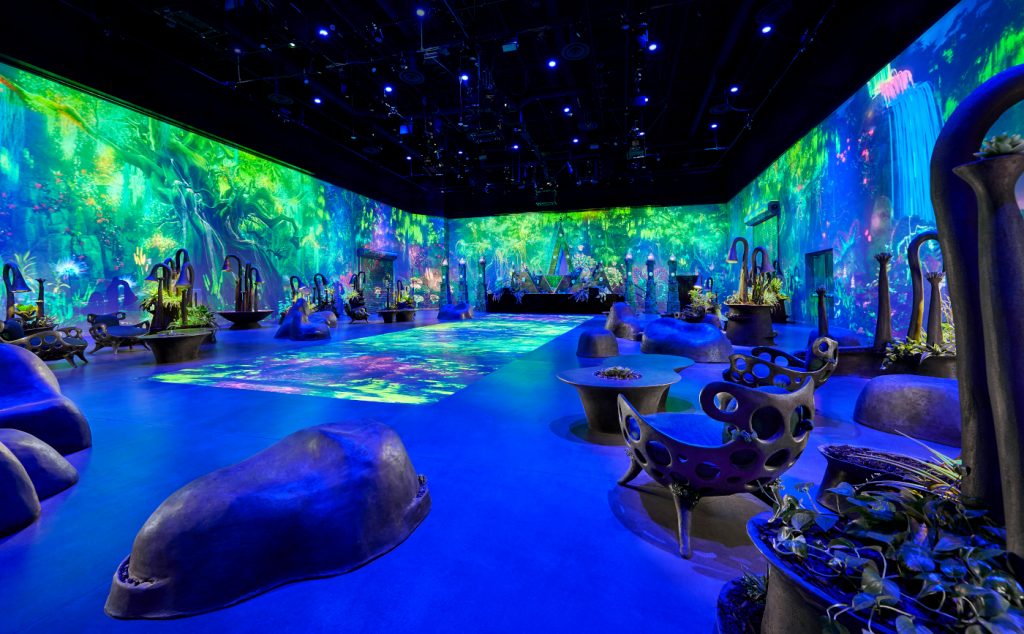From Las Vegas to Brooklyn, experiences are rapidly evolving as spatial sound transforms attractions.
The year is 1993. You’re in the thick of the Rio Hotel and Casino in Las Vegas NV, paying attention to nothing less than the little ball dancing in the wheel of your roulette table, and maybe your glass that—just like your wallet—was full a few minutes ago. And then…the show begins. Colorfully decorated floats with dancers, musicians, and all manner of frills and frolic float by overhead. The music comes from everywhere—from the floats themselves, from musicians playing their part and, yes, from the walls. The entire building supports this experience, transforming the casino into a show. How long does it last? You won’t remember. Maybe 10 minutes? And then, it’s back to the wheel. Wow! You’re ready for some more of whatever it is that they’re serving….
The Vegas Standard
The ’90s and into the first decade of the 21st century, in particular, put the “mm…” in “immersive experience.” The Fremont Street Experience in Las Vegas is a pedestrian mall and barrel-vault canopy that covers four city blocks. This canopy incorporates huge overhead light screens that run up and down the structures—90 feet high at the peak. Multiple loudspeaker positions are incorporated, as well. Both video and audio activate the entire canopy to deliver regular shows with content that changes with the season. This helped the historic downtown to rise again, bringing new audiences to the area. The shows were actually shortened from their initial duration because they were so captivating that casino traffic slowed down too much!
Resident shows like Cirque du Soleil’s “Mystère,” “KÀ,” “O” and The Beatles’ “LOVE” created a completely new genre: the spectacle show. Las Vegas made it a point to create an attraction out of virtually any experience. System and sound designers, including Jonathan Deans (Cirque, Rio) and Alan Howarth (Fremont Street) helped these experiences push the envelope for what audiences would come to expect. Las Vegas became a family destination. Crowds became the norm. And we liked it that way. The more, the merrier!
In 1982’s “I Have the Touch,” Peter Gabriel sings,
“The time I like is the rush hour
’cause I like the rush
The pushing of the people
I like it all so much”
Indeed.
And, yet, here we are. More than a year ago, March 11, 2020, the National Basketball Association (NBA) shuttered its season; we, meanwhile, collectively shuddered. Then venues around the world closed. Invitations to “virtual” events, performances and meetings flooded our inboxes. (A brief digression: Must we call them “virtual”? Are they really unreal? Or just a different kind of real?) Many venues pivoted to online offerings to serve artists, connect to their audiences and even grow their audiences.
Venues Adapt
National Sawdust, in Brooklyn NY, is a flexible music venue that can accommodate audiences of up to 150 seated or 250 standing, and it’s packed with spatial-audio technology. It regularly uses spatial sound and electronically adjustable acoustics to enrich its events, which run the gamut from pop, to classical, to experimental, to everything in between. The venue often features new works created by up-and-coming composers. National Sawdust developed a rich program of online content through its Digital Discovery Festival, which is now ongoing. Still, it seems that, sometimes, we can only dream of being in venues where our experience is elevated by sharing it with others—often, others in very close proximity (certainly within six feet). In many (most?) areas, theaters and shows remain closed even now.
And, yet, just like the wildflowers that invariably spring from the smallest cracks in the pavement, experiences are starting to blossom. They might be scaled down, maybe experienced in a different way, but they’re emerging nonetheless. And spatial audio is playing a part in elevating these experiences.
Immersive Entertainment
Las Vegas’ AREA15 Immersive Entertainment and Events Complex recently opened, and it’s using both a multichannel overhead system and ground-mounted line arrays to deliver immersive audio content, working with musicians such as Max Cooper. In the same complex, Meow Wolf’s Omega Mart also recently opened. The Los Angeles Times noted that its goal is to “marry experimental art, theme-park-inspired design and ambitious ideas on how we play in physical spaces.” And, “as evidenced by Omega Mart selling out its opening weekend, many are ready for a place that feels like a return to normalcy.” Art museums are all about immersive experiences.
Last year, visual artist Casey Reas and Mouse on Mars’ Jan Werner collaborated to premiere “Compressed Cinema” via an online exhibit presented by the Walker Art Center in Minneapolis MN. Earlier this year, they physically mounted this work as “Alchemical” at bitforms gallery in New York NY. The work includes video sections that change between a pair of large projections set at an oblique angle. They expanded their original stereo concept to a multichannel installation that provided overlapping quad configurations, supported by a subwoofer. The event was well attended, and it extended beyond its originally scheduled showing.
Recently, I attended a free public music and video event that featured the music of Brian and Roger Eno and their new album, “Mixing Colours.” Two large video screens showed films that accompany each piece, and the music was played from a pair of ground-mounted line arrays. A colorfully lit fountain bubbled away in the center of the plaza. The music was calm and impressionistic, punctuated by simple piano lines. National Public Radio (NPR) noted, “Some of them feel like they wandered in from a less hectic century.” Rachel S. Moore, President and CEO of The Music Center, said, “As the world comes to terms with our common experience of isolation and self-reflection over the last year, arts experiences are a healing and unifying remedy.” The evening that I attended, there were no other viewers. Perhaps the chilly winds of that particular February evening kept them away.
This reminded me of the potential for pop-up attractions, and, in particular, for outdoor pop-up attractions. What if this installation incorporated loudspeakers that surrounded the plaza? In this particular case, the video screens were fixed in the front, and the area was quite large. So, perhaps, a multichannel installation would not translate as well. On the other hand, though, the individual loudspeaker clusters in a distributed concept wouldn’t have to be as large, and the audio might draw people into the plaza. The work could be experienced sonically in different ways by exploring various listening positions in relation to other local architecture, both physical and sonic. This would also provide the opportunity to encourage musicians to create special, site-specific spatial mixes, or stemmed-out masters, similar to what Cooper did recently in AREA15.
Multichannel audio design for Las Vegas experiences like Masquerade in the Sky, Cirque du Soleil shows, the Fremont Street Experience and others came from a time of audacious experimentation. It felt like every next show had to be bigger and better than the previous one. How can we tap into that spirit now when we design new facilities?

Key Considerations
There are a few considerations that, when followed, can help lay the groundwork to elevate an ordinary installation and transform it into a truly extraordinary immersive experience. What follows are a few design considerations we can glean from this golden age of Las Vegas entertainment technology.
- Install discrete cable runs to each loudspeaker position. Yes, this costs more than zoning by daisy chaining from one loudspeaker to the next. However, individually addressing each loudspeaker will allow you to move the audio along the wall or ceiling, similar to what the Rio accomplished and what is practiced with theme parks’ parade systems.
- Upsize your loudspeakers beyond the requirements for background music (BGM). You might be designing a distributed system for BGM and occasional announcements. For that purpose, you might determine that each loudspeaker must deliver a given sound pressure level (SPL), when the group of them sum, for the primary function. But what if you use a smaller subset of them? What if you have to handle the peaks required for musical passages where the music is now in the foreground, not the background? Increase the capabilities of these loudspeakers. If your budget doesn’t allow for that, at least consider upsizing a distributed subset of them. Be sure to use acoustic-prediction programs to confirm your model selections.
- Speaking of SPLs, let’s talk about subs. An easy way to bring impact to a work is to incorporate subs so that the experience is truly full range. However, many BGM systems don’t incorporate them because…well…they’re background, not foreground, systems. If you can’t afford subs in your system initially, at least explore potential installation locations and run cable to them. That way, you can support subs when, invariably, the facility owner wants to raise the bar for a new event or promotion.
- Design a flexible audio matrix into the front end of your system. It’s all in the matrix. Most spatialization techniques, including Vector Base Amplitude Panning (VBAP), Distance Based Amplitude Panning (DBAP) and others that are incorporated into commercial products, are, at their core, matrix controllers. These can give you the flexibility both to dynamically move or place sound and to create static matrix presets for bread-and-butter system functions, such as BGM.
- Be mindful of the control system. How will you control the system? Choose software that provides dynamic control potential. (Hint: Look no further than the repertory theater down the street from you for inspiration.)
- What about the room’s acoustics? When you’re designing your system, be aware of any other sound or noise sources, such as fountains. The size and reverberation time (RT) of the room will affect the quality of your multichannel sound system. Work with the room, rather than working against it. If you’re outdoors, think about whether you want to create the feeling of a room. If so, consider including a reverberator that can be distributed to all the loudspeakers and applied to the master audio recording.
- Finally, there is content. It’s all about the content. Ultimately, the best experiences are possible when unique stems are available for source tracks. This lets you address each track in a different way. Perhaps you want to move a percussion track slowly around the room, but you want to keep the bass grounded. This is most easily accomplished if you provide a spec for content creators to help them bring their work to life.
If you follow the tips provided in this article, there’s nothing stopping your atrium, museum or mall project from being transformed into a spatial-audio extravaganza.
To read more from Sound & Communications, click here.

